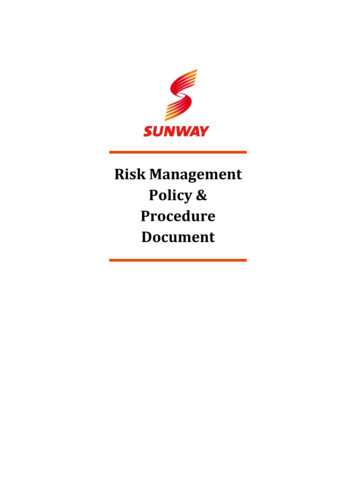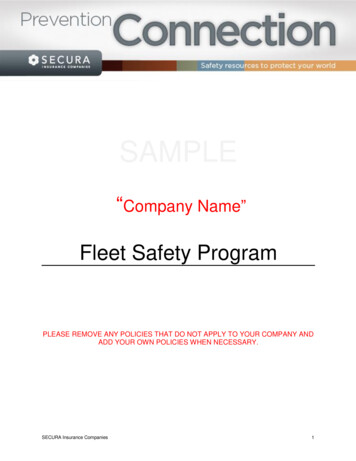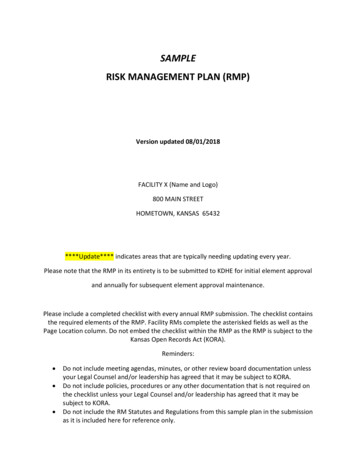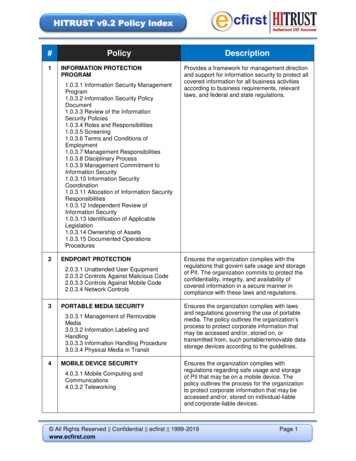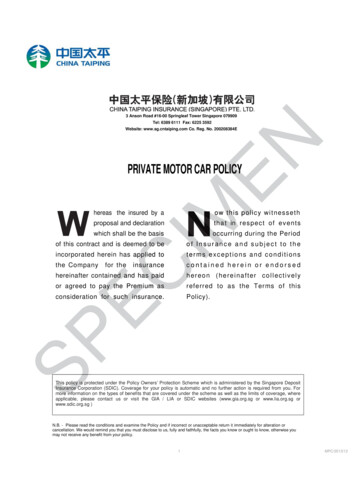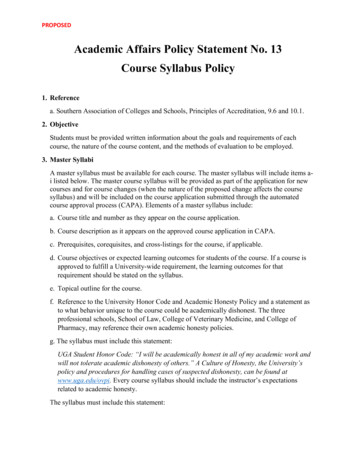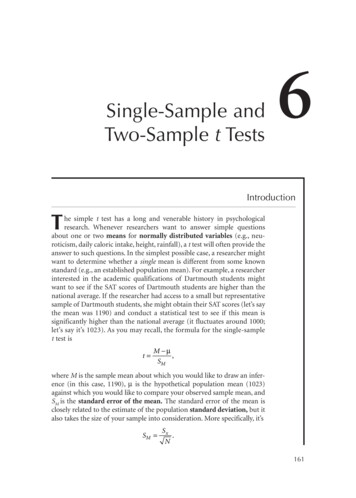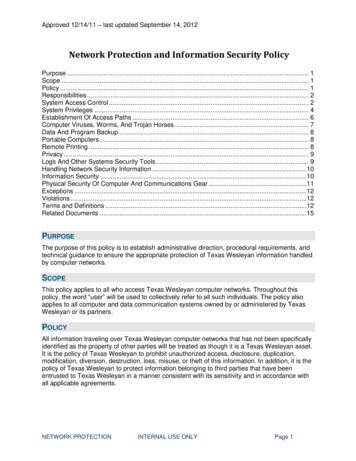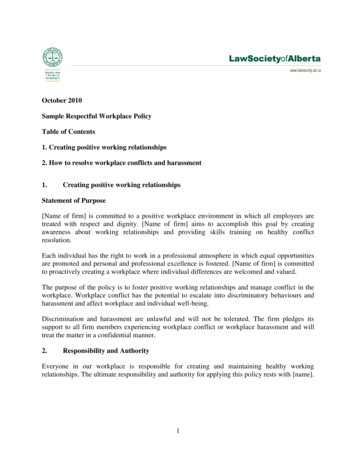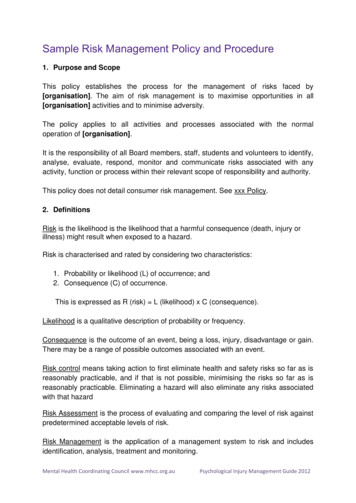
Transcription
Sample Risk Management Policy and Procedure1. Purpose and ScopeThis policy establishes the process for the management of risks faced by[organisation]. The aim of risk management is to maximise opportunities in all[organisation] activities and to minimise adversity.The policy applies to all activities and processes associated with the normaloperation of [organisation].It is the responsibility of all Board members, staff, students and volunteers to identify,analyse, evaluate, respond, monitor and communicate risks associated with anyactivity, function or process within their relevant scope of responsibility and authority.This policy does not detail consumer risk management. See xxx Policy.2. DefinitionsRisk is the likelihood is the likelihood that a harmful consequence (death, injury orillness) might result when exposed to a hazard.Risk is characterised and rated by considering two characteristics:1. Probability or likelihood (L) of occurrence; and2. Consequence (C) of occurrence.This is expressed as R (risk) L (likelihood) x C (consequence).Likelihood is a qualitative description of probability or frequency.Consequence is the outcome of an event, being a loss, injury, disadvantage or gain.There may be a range of possible outcomes associated with an event.Risk control means taking action to first eliminate health and safety risks so far as isreasonably practicable, and if that is not possible, minimising the risks so far as isreasonably practicable. Eliminating a hazard will also eliminate any risks associatedwith that hazardRisk Assessment is the process of evaluating and comparing the level of risk againstpredetermined acceptable levels of risk.Risk Management is the application of a management system to risk and includesidentification, analysis, treatment and monitoring.Mental Health Coordinating Council www.mhcc.org.auPsychological Injury Management Guide 2012
Risk Owner is the person(s) responsible for managing risks and is usually the persondirectly responsible for the strategy, activity or function that relates to the risk.3. PrinciplesRisk management is a key governance and management function.[organisation] is proactive in its approach to risk management, balances the cost ofmanaging risk with anticipated benefits, and undertakes contingency planning in theevent that critical risks are realised.[organisation] has the primary duty to ensure the health and safety of workers andother persons at the workplace. A duty to ensure health and safety requires[organisation] to manage risks: by eliminating health and safety risks so far as is reasonably practicable; and if it is not reasonably practicable to eliminate the risks, by minimising thoserisks so far as is reasonably practicable.Deciding what is ‘reasonably practicable’ to protect people from harm requiresweighing up certain matters, including the likelihood of a hazard or risk occurring andthe degree of harm that would result, and then making a judgement about what isreasonable in the circumstances.Effective risk management involves: a commitment to health and safety from the [organisation] Board of Directors the involvement and cooperation of [organisation]’s workers4. OutcomesAs far as is reasonably practicable, workers, consumers and other persons are notput at risk from work carried out by [organisation].[organisation] is protected from adverse incidents, reduces its exposures to loss,and mitigates and controls loss should it occur.[organisation] has ongoing, unimpeded capacity to fulfil its mission, perform its keyfunctions, meet its objectives and support its consumers.The costs of risk to [organisation], and its funders, is reduced.Mental Health Coordinating Council www.mhcc.org.auPsychological Injury Management Guide 2012
5. Functions and DelegationsA person can have more than one duty and more than one person can have thesame duty at the same time.PositionBoard of DirectorsDelegation/TaskExercise due diligence to ensure that [organisation] complies with theWHS Act and Regulations. This includes taking reasonable steps to: gain an understanding of the hazards and risks associated with the operations of [organisation], and ensure that [organisation] has and uses appropriate resourcesand processes to eliminate or minimise risks to health and safety.CEOEnsure, so far as is reasonably practicable, that workers and otherpersons are not put at risk from work carried out by [organisation].ManagementStaffEnsure, so far as is reasonably practicable, that: the workplace, including entry and exit and anything arising fromthe workplace are without risks to health and safety the fixtures, fittings or plant are without risks to health and safety the plant, substance or structure is without risks to health andsafety.Establish and implement risk management systems for all functions andactivities of [organisation].Compliance with Risk Management Policy.Contribute to the establishment and implementation of risk managementsystems for all functions and activities of [organisation].6. Risk ManagementAll Board members and staff contribute to the establishment and implementation ofrisk management systems for all functions and activities of [organisation].Risk management practice aligns with all federal and state legislation.7. Policy ImplementationRisk management forms part of strategic, operational and line managementresponsibilities, and is integrated into strategic and service planning processes.Risk management is embedded in all policies and procedures, with workerscontributing to risk management systems.Mental Health Coordinating Council www.mhcc.org.auPsychological Injury Management Guide 2012
8. Policy Detail[organisation] aims to achieve better practice in the management of risks thatthreaten to adversely impact on [organisation], its functions, objectives, operations,assets, staff, consumers or members of the public.[organisation] does whatever it can(whatever is ‘reasonably practicable’) toensure its workers, consumers and otherpeople are not harmed by its activities.Risk management involves four steps(see Figure 1 below):1. identify hazards – find out whatcould cause harm2. assess risks – understand thelikelihood of a hazard causing harmand how serious it could be,3. control risks – implement the mosteffective control measure that isreasonably practicable in thecircumstances, and4. review control measures to ensurethey are working as planned.Figure 1: The risk management process(from Worksafe Australia, 2010, p6)Many hazards and their associated risks are well known and have well establishedand accepted control measures. In these situations, the second step to formallyassess the risk is unnecessary.If, after identifying a hazard, we already know the risk and how to control iteffectively, [organisation] just implements the controls.8.1 Consulting with workersConsultation with workers and their health and safety representatives is required ateach step of the risk management process. By drawing on the experience,knowledge and ideas of its workers [organisation] is more likely to identify allhazards and choose effective risk controls.[organisation] workers must follow safety instructions and procedures, and they willdo this more effectively if they are involved in the development of these procedures,understand the reasons for them and how they work.Mental Health Coordinating Council www.mhcc.org.auPsychological Injury Management Guide 2012
[organisation] encourages its workers to report any hazards and health and safetyproblems immediately so that risks can be managed before an incident occurs.If [organisation] has a health and safety committee, [organisation] will engage thecommittee in the risk management process as well. For more details, see WHSConsultation Procedure.8.2 When should a risk management approach be used?Managing work health and safety risks is an ongoing process that is triggered whenchanges affect [organisation]’s work activities – changes such as: New program start-up changing work practices, procedures or the work environment purchasing new or used equipment or using new substances planning to improve productivity or reduce costs new information about workplace risks becomes available responding to workplace incidents (even if they have caused no injury) responding to concerns raised by workers, health and safety representativesor others at the [organisation] workplace, and as required by WHS regulations for specific hazards[organisation] also uses the risk management approach when designing andcreating products, processes or places used for work, because it is often easier andmore effective to eliminate hazards before they are introduced into a workplace andto incorporate safety features in the early stages of product or process development.8.3 STEP 1 – HOW TO IDENTIFY HAZARDSIdentifying hazards involves finding all of the things and situations that couldpotentially cause harm to people. Hazards generally arise from three aspects of workand their interaction: The physical work environment The equipment, materials and substances used The work tasks and how they are performedSome potential hazards that may be encountered at [organisation] include:a) Manual tasks: overexertion or repetitive movement can cause muscular strainb) Electricity: potential ignition source; exposure to live electrical wires can causeshock, burns or death from electrocution,c) Noise: exposure to loud noise can cause permanent hearing damageMental Health Coordinating Council www.mhcc.org.auPsychological Injury Management Guide 2012
d) Biological: viruses, bacteria, fungi can cause hepatitis, legionnaires’ disease,Q fever, HIV/AIDS, allergiese) Psychosocial hazards: effects of work-related stress, bullying, violence andwork-related fatigue8.3.1 How to find hazardsInspect the workplaceRegularly walking around the workplace and observing how things are done can helpyou predict what could or might go wrong. Look at how people actually work, howplant and equipment is used, what chemicals are around and what they are used for,what safe or unsafe work practices exist as well as the general state ofhousekeeping.Things to look out for include: Does the work environment enable workers to carry out work without risks tohealth and safety (for example, space for unobstructed movement, adequateventilation, lighting)? How suitable are the tools and equipment for the task and how well they aremaintained? Have any changes occurred in the workplace which may affect health andsafety? If workers have developed a shortcut, is it safe?Hazards are not always obvious. Some hazards can affect health over a long periodof time or may result in stress (such as bullying) or fatigue (such as shiftwork). Alsothink about hazards that you may bring into your workplace as new, used or hiredgoods (for example, worn insulation on hired welding set).As you walk around, you may spot straightforward problems and action should betaken on these immediately, for example, cleaning up a spill. If you find a situationwhere there is immediate or significant danger to people, move those persons to asafer location first and attend to the hazard urgently.Make a list of all the hazards you can find, including the ones you know are alreadybeing dealt with, to ensure that nothing is missed. You may use a checklist designedto suit your workplace to help you find and make a note of hazards.Consult your workersAsk your workers about any health and safety problems they have encountered indoing their work and any near misses or incidents that have not been reported.Worker surveys can also be undertaken to obtain information about matters such asworkplace bullying, as well as muscular aches and pains that can signal potentialhazards.Mental Health Coordinating Council www.mhcc.org.auPsychological Injury Management Guide 2012
Review available informationInformation and advice about hazards and risks relevant to particular industries andtypes of work is available from regulators, industry associations, unions, technicalspecialists and safety consultants.Manufacturers and suppliers can also provide information about hazards and safetyprecautions for specific substances (safety data sheets), plant or processes(instruction manuals).Review incident records and dataAnalyse your records of workplace incidents, near misses, worker complaints, sickleave and the results of any inspections and investigations to identify hazards. Ifsomeone has been hurt doing a particular task, then a hazard exists, which couldhurt someone else. These incidents need to be investigated to find the hazard thatcaused the injury or illness.8.4 STEP 2 – HOW TO ASSESS RISKSA risk assessment involves considering what could happen if someone is exposed toa hazard and the likelihood of it happening. A risk assessment can help youdetermine: how severe a risk is whether any existing control measures are effective what action you should take to control the risk, and how urgently the action needs to be taken.A risk assessment can be undertaken with varying degrees of detail, depending onthe type of hazards and the information, data and resources that you have available.It can be as simple as a discussion with your workers or involve specific risk analysistools and techniques recommended by safety professionals.8.4.1 When should a risk assessment be carried out?A risk assessment should be done when: there is uncertainty about how a hazard may result in injury or illness, or the work activity involves a number of different hazards and there is a lack ofunderstanding about how the hazards may interact with each other to producenew or greater risks.A risk assessment is mandatory under the WHS Regulations for some hazards, forexample, entry into confined spaces.Mental Health Coordinating Council www.mhcc.org.auPsychological Injury Management Guide 2012
A risk assessment is not necessary in the following situations: Legislation requires some hazards or risks to be controlled in a specific way –these requirements must be complied with. A code of practice or other guidance sets out a way of controlling a hazard orrisk that is applicable to your situation and you choose to use therecommended controls. In these instances, the guidance can simply befollowed. There are effective controls that are in widespread use in the particularindustry, that are suited to the circumstances in your workplace. Thesecontrols can simply be implemented.8.4.2 How to do a risk assessmentAll hazards have the potential to cause different types and severities of harm, rangingfrom minor discomfort to a serious injury or death.Some hazards such as noise and atmospheric contaminants may require scientifictesting or measurement to accurately assess the risk (for example, using noisemeters to measure noise levels).Work out the amount of harm that could occurTo estimate the amount of harm that could result from each hazard you shouldconsider the following questions: What type of harm could occur (e.g. muscular strain, fatigue, burns,laceration)? How severe is the harm? Could the hazard cause death, seriousinjuries, illness or only minor injuries requiring first aid? What factors could influence the severity of harm that occurs? For example,the distance someone might fall or the concentration of a particular substancewill determine the level of harm that is possible. The harm may occurimmediately something goes wrong (e.g. injury from a fall) or it may take timefor it to become apparent (e.g. illness from long term exposure to asubstance). How many people are exposed to the hazard and how many could be harmed(in and outside your workplace)? Could one failure lead to other failures? For example, could the failure of yourelectrical supply make any risk controls that rely on electricity ineffective? Could a small event escalate to a much larger event with more seriousconsequences? For example, a minor fire can get out of control quickly in thepresence of large amounts of unnecessary combustible materials.Mental Health Coordinating Council www.mhcc.org.auPsychological Injury Management Guide 2012
Work out how hazards may cause harmIn most cases, incidents occur as a result of a chain of events and a failure of one ormore links in that chain. If one or more of the events can be stopped or changed, therisk may be eliminated or reduced.One way of working out the chain of events is to determine the starting point wherethings begin to go wrong and then consider: ‘If this happens, what may happennext?’ This will provide a list of events that sooner or later causes harm.In thinking about how each hazard may cause harm, you should consider: the effectiveness of existing control measures and whether they control alltypes of harm, how work is actually done, rather than relying on written manuals andprocedures, and infrequent or abnormal situations, as well as how things are normally meant tooccur.Consider maintenance and cleaning, as well as breakdowns of equipment (egcomputers, vehicles) and failures of health and safety controls.Work out the likelihood of harm occurringThe likelihood that someone will be harmed can be estimated by considering thefollowing: How often is the task done – does this make the harm more or less likely? How often are people near the hazard? How close do people get to it? Has it ever happened before, either in your workplace or somewhere else?How often?You can rate the likelihood as one of the following: Certain to occur - expected to occur in most circumstances Very likely - will probably occur in most circumstances Possible – might occur occasionally Unlikely – could happen at some time Rare – may happen only in exceptional circumstancesThe level of risk will increase as the likelihood of harm occurring and its severityincreases.8.5 STEP 3 – HOW TO CONTROL RISKSThe most important step in managing risks involves: eliminating them so far as is reasonably practicable, or if that is not possible, minimising the risks so far as is reasonably practicable.Mental Health Coordinating Council www.mhcc.org.auPsychological Injury Management Guide 2012
In deciding how to control risks you must consult your workers and theirrepresentatives who will be directly affected by this decision. Their experience willhelp you choose appropriate control measures and their involvement will increase thelevel of acceptance of any changes that may be needed to the way they do their job.There are many ways to control hazards and risks. Some controls are more effectivethan others.You should consider variouscontrol options and choose thecontrol that most effectivelyeliminates the hazard orminimises the risk in thecircumstances. This may involve asingle control measure or acombination of different controlsthat together provide the highestlevel of protection that isreasonably practicable.HIGHESTLevel 1MOSTEliminate the hazards(from WorksafeAustralia 2010)Level 2Substitute the hazard with somethingsaferIsolate the hazard from peopleReduce the risks through engineeringcontrolsLevel 3Some problems can be fixedeasily and should be done straightaway, while others will need moreeffort and planning to resolve. Ofthose requiring more effort, youshould prioritise areas for action,focusing first on those hazardswith the highest level of risk.Reduce the level of harm usingadministrative actionsUse personal protective equipmentLOWESTLEASTFigure 2: The hierarchy of control(from Worksafe Australia 2010)8.5.1 The hierarchy of controlThe ways of controlling risks can be ranked from the highest level of protection andreliability to the lowest as shown in Figure 2.This ranking is known as the hierarchy of control.You must always aim to eliminate a hazard, which is the most effective control. If thisis not reasonably practicable, you need to minimise the risk by working through theother alternatives in the hierarchy.Level 1 control measuresThe most effec
Mental Health Coordinating Council www.mhcc.org.au Psychological Injury Management Guide 2012 8. Policy Detail [organisation] aims to achieve better practice in the management of risks that threaten to adversely impact on [organisation], its functions, objectives, opera
